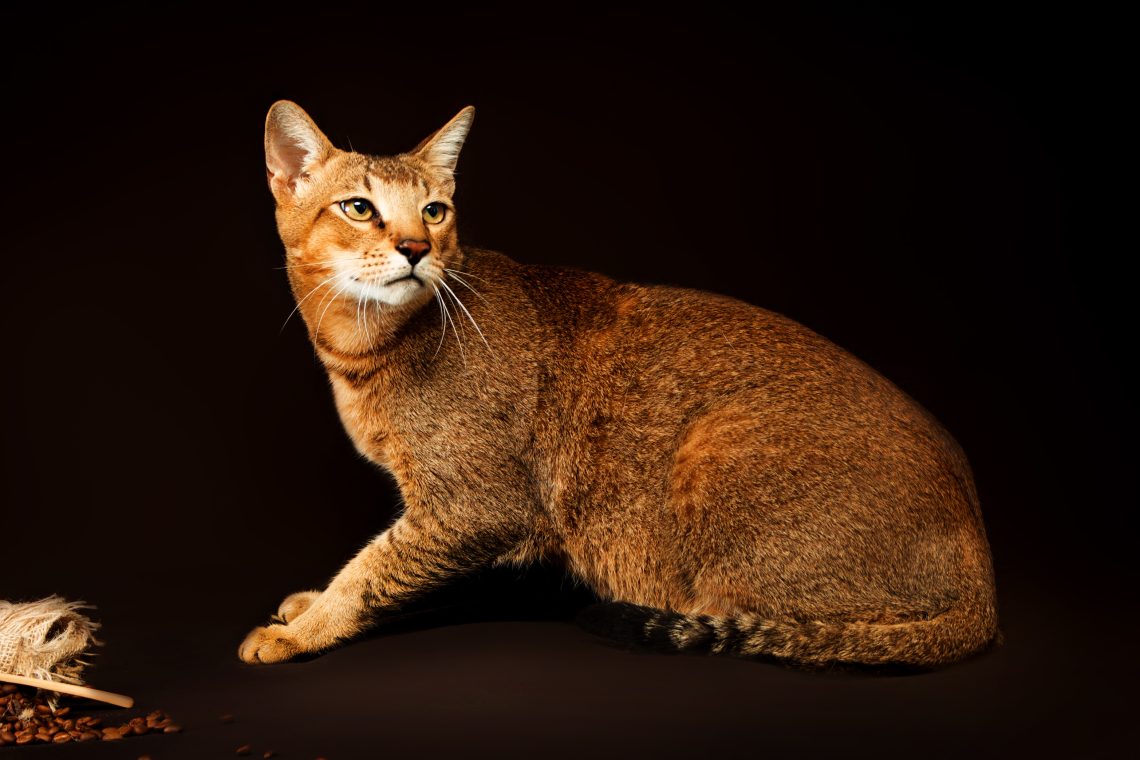
Chausie cat – all about the breed, care and other important points + photo
Chausie cats are among the rarest and most expensive breeds in the world. Basically, these animals are bred in America, where the history of the breed began. Now nurseries have appeared in Russia. Chausies are expensive animals: not everyone can afford to pay several thousand dollars for a kitten. The chausie combines exotic appearance and good disposition. Animals are attached to their owners, adore children and easily get along with other cats and dogs. At the same time, they look like large wild cats with a proportional figure and silky hair. The appearance of a beast from the forest, intelligence, hunting instincts and at the same time kindness to people and dog devotion to the owner – this combination attracts cat lovers, forcing them to admire this breed and keep it even in city apartments.
Contents
History and features of the Chausie breed
The wild reed cat, or swamp lynx, is called Felis Chaus in Latin, it is from this concept that the name of the breed came – Chausie (Chausie). An adult male can reach 50 cm at the withers and weigh up to 15 kg. It lives in the lowlands of rivers or lakes, in swampy places where there are thickets of sedge, reeds, reeds, in which the swamp lynx hides. Its coloring is ideal for camouflage in thickets of coastal vegetation. The predator perfectly swims, dives and catches fish, transferring this attractive quality to the Chausie breed – they are not afraid of water at all. Some species of reed cat are listed in the Red Book.
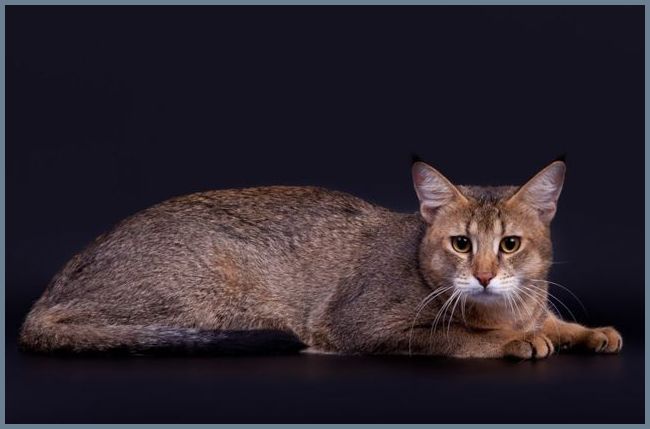
The progenitor of the Chausie breed is the reed cat (Felis chaus), which lives in Central Asia, eastern Eurasia, and African river valleys.
The swamp lynx, which lives in Egypt on the banks of the Nile, first came to the locals about three thousand years ago. It was the Egyptians who tamed these animals, which is reflected in the drawings that have survived to this day on papyrus scrolls. Reed cats lived in people’s homes and helped them hunt ducks, swimming to reach the shot prey and bringing it to the owner. Unfortunately, except for the Egyptians, no one was engaged in taming these smart and beautiful predators.
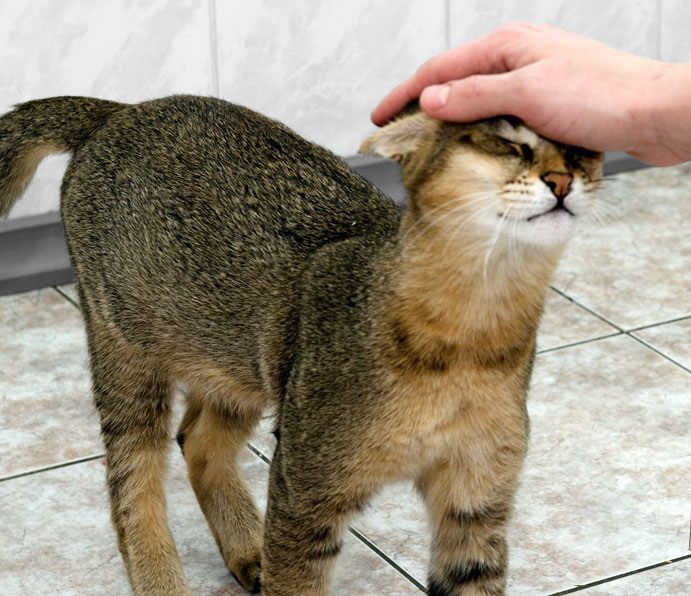
The Egyptians tamed the swamp lynx and used it to hunt ducks.
Origin and standards
The history of the Chausie breed began in the 60s of the XX century, when one of the American tourists who visited the Middle East drew attention to an unusual type of cats roaming the streets. The fact is that wild reed cats (jungle cat) often penetrated into abandoned houses in order to hunt mice that eat up the remains of human supplies. Periodically, wild animals mated with domestic cats and hybrid kittens were born, which were noticed and taken away by a curious American. As a result, a new cat breed was registered in the TICA registry in 1995, and the official status was given to it in 2003.
The goal of the breeders was to breed cats with the appearance and temperament of a predator, but with the character of a pet. The process was not easy, because Chausie is difficult to breed. At best, 50 percent of the litter consists of purebred kittens, and most males are sterile. In the breeding process, reed cats are most often bred with Abyssinian cats, so the color and appearance of the Chausie resemble the Abyssinian. Much less often, various short-haired breeds and Bengal cats are involved in crossing.
The appearance and character of pets are determined by the generation and percentage of Felis Chaus blood. These features are denoted by the index F (branch) and a number.
Table: ability to reproduce
It is the F1 chausie that is the most valuable, because it most closely resembles its wild ancestor with its appearance. Stately athletic build, large ears, sometimes with tassels. Tassels should always be black. A typical feature of the F1 Chausie are the “deceptive eyes”: characteristic stripes and spots on the back of the ears. In nature, such patterns help the swamp lynx to warn everyone who is behind and carries danger: “I see you!”.
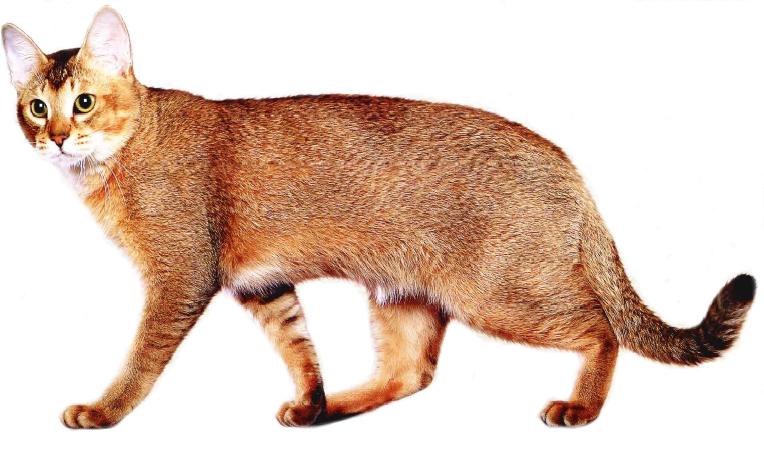
The characteristic pattern on the large ears of the Chausie imitates a second pair of eyes at the back to scare off enemies.
Chausie males are about 20% larger than females. A cat can be up to 40 cm tall at the withers and weigh up to 15 kg. The Chausie F1 breed standard consists of several characteristic features:
- The head is of medium size, with an angular chin and pronounced cheekbones, a domed forehead, and an elongated nose.
- The ears are large, erect, with rounded tips, set high, sometimes with black tassels at the ends.
- The eyes are almond-shaped, most often amber in color, but green shades are also allowed.
- The neck is short, powerful.
- The body is elongated, elegant outlines, with high large paws.
- The tail is quite long, equal to about 3/4 of the body size, the tip is black.
- The coat is short, dense and silky, beautifully shimmers in the sun.
Separately, it is worth dwelling on the coloring of the chausie. In general, the pattern on the body can be blurry, but clarity and symmetry should be observed on the head, paws and tail, and on the neck it should resemble a necklace.
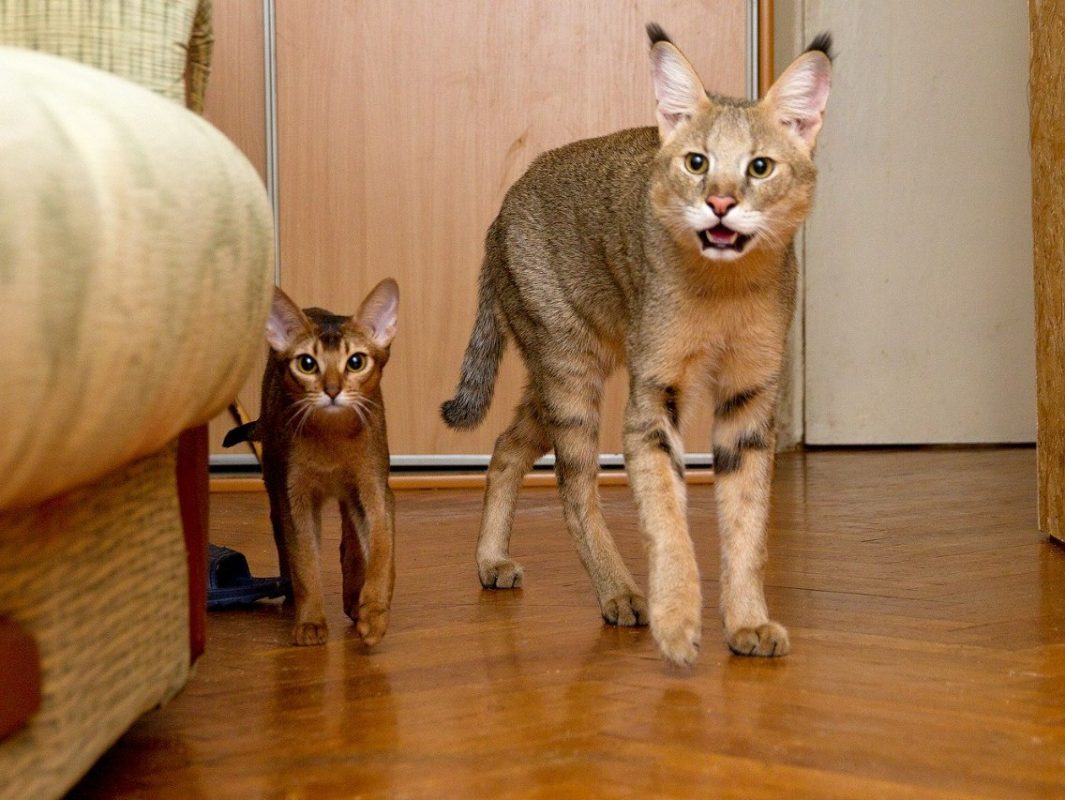
Most Chausies are ticked tabby in color, this color is the most popular with buyers.
There are three types of Chausie color: ticked tabby, ticked silver and black. The word “ticked” means that each hair of wool is equally and evenly colored in zones in different shades. On the hair, 2–3 dark stripes are usually visible on a lighter background. This double or triple zoning gives the ticked skins a unique play of color and a slight shimmer.
Not so long ago, reed cats were hunted for fur coats because of the beauty of their fur, but at the moment, due to a strong decrease in the number of Felis Chaus, hunting for them is prohibited.
Character
The main features of the Chausie are sociability, stability and affection for the owner. The breeders really managed to breed a breed with an almost perfect character. These animals are able to literally feel their owner and anticipate his desires. Americans consider the Chausie to be the best companion cat.
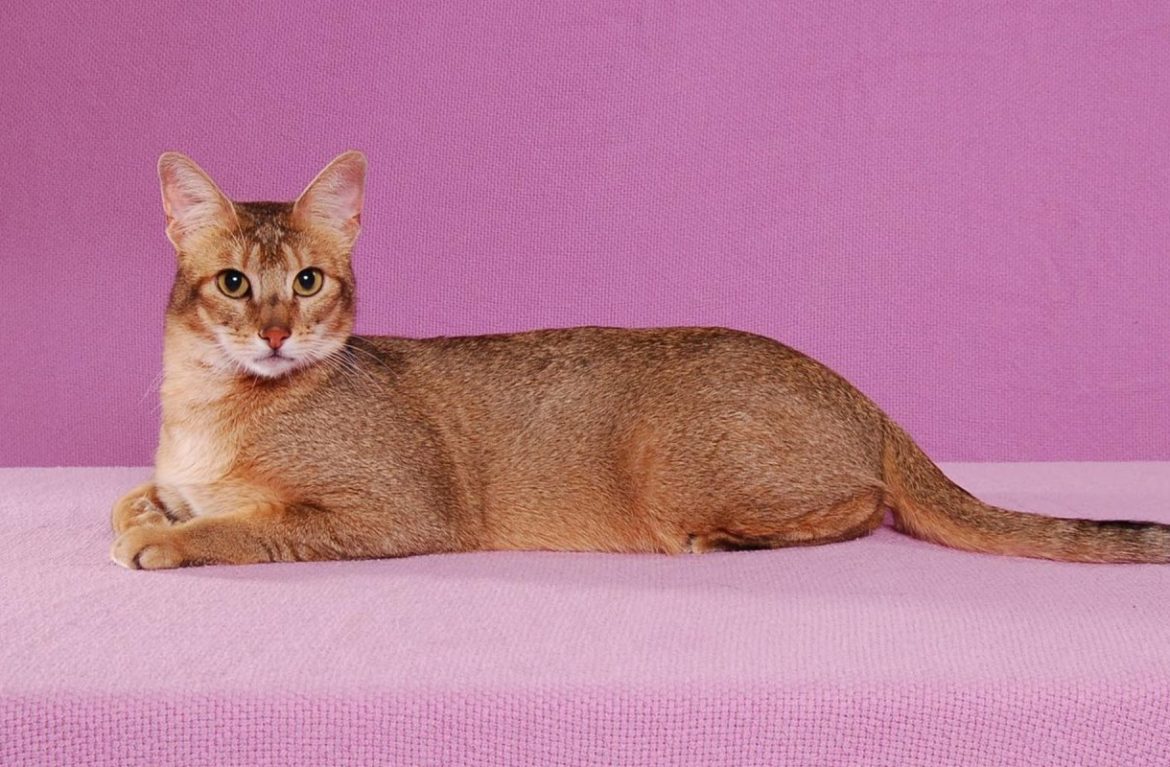
Chausie are sociable and very attached to the owner, and their devotion to him is more like a dog
The descendants of reed cats get along well and play with children, get along well with other cats or dogs, and even with large parrots. But Chausie will perceive hamsters, birds or fish as prey, so it is better not to provoke a wild hunt in your home.
The amazing quality of these cats is that they practically do not scratch, because when they come into contact with human skin, their claws instantly retract. A very handy feature for playing with children. However, their claws themselves are decent, and they use them quite actively, so it is necessary to have a scratching post in the house. Chausies also love to learn something new, especially if they receive delicious prizes for it.
Chausies love to play, so there should be toys for them in the house. Owners sometimes need to set aside time to play with their pet. Otherwise, the chausie will have fun on its own, which usually does not affect the condition of the apartment or house in the best way.
The apartment should have toys and space for active games.
Chausi love to climb cabinets and mezzanines, like wild ancestors lying in wait for prey in the trees. Therefore, it is good if the house has upper-level spaces where cats can move around, jump and play.
It is typical for a Chausie to stock up – he is able to steal something in the kitchen and hide it in a secluded place until better times. Knowing this feature, the owners need to carefully monitor the cat in order to avoid unpleasant odors of unclear origin from their pet’s cache.
And finally, chausies are not at all afraid of water, moreover, they love it, swim well and know how to fish. Therefore, the presence of an aquarium in the house is excluded. But swimming with the owner in the bathroom or climbing into the river or lake after him is a common thing for these amazing cats.
Representatives of this breed love to swim and play in the water.
Video: Chausie cats
How to choose a kitten
Acquiring a Chausie kitten is not an easy task, because this breed is not yet as popular in Russia as in America, and there are very few catteries dealing with Chausie. Nevertheless, they exist, and information about them can be found on the Internet. This breed is not only rare, but also expensive – an F1-F2 kitten costs several thousand dollars.. Breeding a Chausie is a complicated matter, and only catteries have the right to do so, so if you want to get a real representative of this breed, with wild genes in your blood, you need to choose a kitten there, and not from private breeders. Kittens of generations F3, F4 will cost much less.
Chausie kitten must be purchased in a specialized cattery
Usually nurseries give away three-month-old kittens. When choosing a kitten, you need to pay attention to the competence of the specialists accompanying your purchase: how much they are aware of the characteristics of the breed, how quickly and in detail they answer questions. Looking closely at the kittens, you need to evaluate their appearance and behavior. The appearance of the little chausie should have the following characteristic features: triangular muzzle, wide and high ears, ticked coat color, black tip of the tail. You need to carefully examine the kitten’s coat: it should not have bald spots and dandruff. The ears and eyes of a healthy animal are clean, the claws on the paws are in the right amount and not deformed.
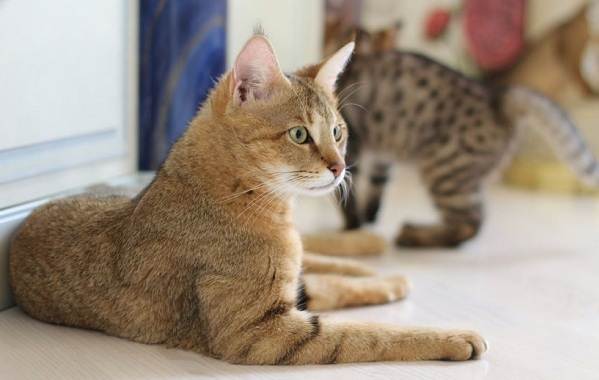
When choosing a kitten, you need to pay attention to the severity of his signs of the Chausie breed.
By the behavior of the baby, you can judge the state of his health. Healthy kittens are very curious, active and always ready to play. See how they communicate and interact with each other: this is very useful information about the nature of the future pet. Signs such as passivity, drowsiness, shyness of the kitten, as well as its excessive aggressiveness should alert. Given the kind and cheerful disposition of representatives of this breed, the kitten should greet potential owners affably, although, of course, situations are different. Kittens can simply get tired of a large flow of visitors.
It’s good to be able to see the kitten’s parents, this will help you to clearly imagine what your adult cat or cat will look like. If this is not possible, then usually nurseries provide photographs of the parents.
By the way, while still at home, you can see photos of kittens for sale and read their characteristics. Usually on the websites of good catteries there is all the information about the producers, kittens and even about the alleged litters. You can reserve a kitten you like, and then go to see it live.
When choosing a kitten, it will be useful to look at his parents.
The nursery staff must provide you with all documents for the animal, including a card with its date of birth, nickname and pedigree, as well as a veterinary passport with information about deworming and vaccination. The transaction is drawn up in accordance with the official contract of sale, which should contain such items as sterilization or castration of the animal, as well as the possibility of its participation in exhibitions.
Pet Care
When getting a cat or a Chausie cat, do not forget that this is a very active and curious creature that needs space and interesting activities. Being locked in four walls is very difficult for him. It is ideal to keep Chausies in a private house or cottage with a large yard where they can walk and climb trees. The best nurseries have their own private territory for animal walks.
Features of the content in the apartment
The apartment in which the Chausie lives must be spacious enough. Representatives of this breed are distinguished by their solid size, and also love to run, jump and climb. Therefore, they need free space for movement. In addition, Chausie must be walked 2-3 times a week, using a harness and leash for this. Cats tolerate walking with the owner well, behave calmly and obediently, so you can go out with them more often. It is good if there is a suitable park or square nearby. It is good to take the animal with you on country walks and picnics, as well as take it to the country in the summer.
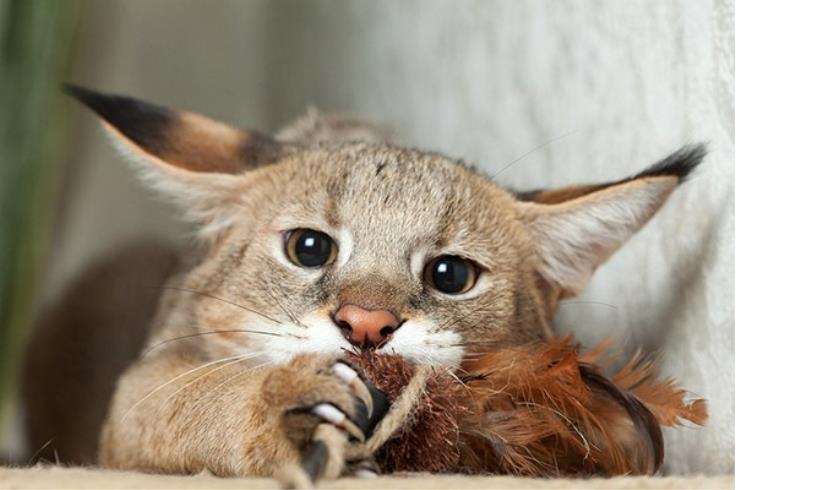
Representatives of the breed have a positive attitude towards walking on a leash and their owners are advised to do this as often as possible.
For owners, such a pet combines the features of a cat and a dog: you can and should walk with him, and he is also quite capable of defending himself, and with appropriate training, he can understand and execute voice commands and bring objects to the owner.
These cats are distinguished by increased sociability, they require attention and can attract it specially in all available ways. At the same time, they are very agile and agile. Therefore, it is better not to have unstable or poorly fixed fragile items in the apartment. And to help your pet realize its wild nature, you can buy special high houses and ladders for it, equip shelves under the ceiling, which you can climb on, hide and watch what is happening below. This is exactly what marsh lynxes often do. And be sure to have scratching posts in the house, otherwise carpets and sofas will serve as such.
Shelves and ladders that you can jump and climb on will help the Chausie channel his energy into a peaceful direction.
Chausies love children, and children love to play, so children and cats get along well and entertain each other. It is necessary to offer the child interesting toys for playing with chausie: fishing rods, mice, ropes, balls and rustlers. If there are no children in the apartment, then the owner himself will have to entertain the pet. The presence of other animals, cats or dogs in the house, will make life easier for a sociable chausie – there will be someone to start fun games and races around the apartment with.
And do not forget about the tendency of Chausie to steal in order to secure food in reserve: they can steal food from the table and even from cabinets. Little lynxes quickly learn to open doors and pull out drawers. You should not be angry with them for this, because this is wild survival instincts playing in the blood.
And keep small rodents and birds away from the chausie: even a fully fed and contented animal may want to hunt with all the ensuing consequences. It is better not to keep predators and their potential victims in the same apartment. The only exceptions are large parrots that can stand up for themselves.
Hygiene
Chausie is not accustomed to the tray immediately, but with due patience of the owner, they can even learn to go to the toilet. Tray problems are more common in Chausie F1.
As for personal hygiene, the wool of these animals is naturally clean and free of foreign odors. This helps them hunt successfully. Caring for them comes down to combing the hair with a massage brush once a week. This removes loose hair and stimulates the blood supply to the skin. Chausies are quite tolerant of combing, and some of them even enjoy it.
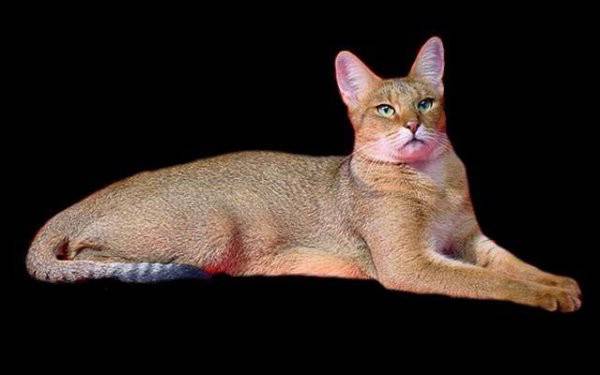
The only grooming accessory a Chausie owner will need is a good brush to brush out their thick coat.
Chausie water procedures are only welcome, so you can bathe them at least every day. However, this should not be abused in order to avoid washing out the natural fat from the wool. Chausie is quite capable of independently coming to the owner in the shower or bath and keep him company. In this case, you can stock up special floating toys for them and ensure a comfortable water temperature.
Like all breeds descended from wild predators, chausies are quite loving, so if breeding is not planned, then it is better to castrate males. This also applies to sterile individuals – sterility does not prevent them from fully showing signs of sexual hunting and marking corners.
It is necessary to regularly examine the eyes and ears of the pet and, if necessary, clean them with a damp cloth. Also, do not forget about oral hygiene, because an abundance of plaque can lead to the appearance of stones on the teeth and the development of caries. To prevent trouble, you need to let the cat chew on the tendons and cartilage from the bones, this will help clean the dental tissue. A good way out is the use of a special paste for animals.
Food
Chausie digestion and diet require special attention. The fact is that their intestines are shorter than usual, which is why they are not able to normally digest cereals and other heavy foods. Therefore, most ready-made feeds, even premium ones, are completely unsuitable for them. In addition, the Chausie have a tendency to overeat, this trait they inherited from the ever-hungry wild ancestors.
It is known that a cat can survive without food for about two weeks, without drinking – no more than two days.
Most breeders recommend feeding Chausie raw meat. The only exception is pork, the use of which can lead to animal diseases. Fresh dietary meat with bones is best suited: poultry, beef, rabbit, and also fish. So that the pet does not become infected with helminths, you can scald the meat with boiling water. And be sure to regularly conduct a course of deworming.
These cats can be given almost any meat except pork, as well as 3 times a week to feed fish
In addition to butchered poultry, small predators can be fed with day-old chicks, quails and fodder mice, as well as raw quail eggs. In addition, it is allowed to add offal (necks, hearts, stomachs, liver, lungs), fermented milk products with a fat content of not more than 10% (kefir, sour cream, cottage cheese, fermented baked milk) and vegetables to the pet’s diet. In addition to pork, flour products, potatoes and cereals are prohibited. With properly organized nutrition, a representative of the Chausie breed can live 15–20 years.
The best food for chausie is dietary raw meat
Kittens, after switching from mother’s milk to regular food, are regularly given vitamins and calcium supplements, and continue to do so until they reach 2 years of age. Kittens up to a year are fed twice a day, adult animals once. It is important that the weight of the serving should be 5% of the pet’s weight. Chausies will gladly eat much more, but the task of the owner is to prevent them from overeating and gaining excess weight. It’s definitely not good for your cat’s health. It is better to immediately remove excess food from the eyes of the Chausie to avoid temptations. At the same time, the cat should have free access to clean drinking water. Water should be boiled or filtered.
For adult animals, a fasting day once a week will be very useful, when they do not receive food, they only drink water. This will prolong the chausie’s life and improve health.
However, some breeders still use ready-made food to feed the Chausie. But this is exclusively grain-free super premium food for animals with sensitive digestion, from well-known companies such as Nutro Choice, Royal Canin, Eukanuba, lams, Pro Plan, Hills.
Pregnancy and childbirth
Breeding Chausie is not an easy task. Even acquiring a couple of the first generation, already in the next litter the value of the parents will be lost by half. And outwardly it is perfectly noticeable. In the rest of the generations, the cats do not bring homogeneous purebred offspring, most often the majority of kittens in the litter are completely ordinary. Thus, it is rare to get a successful result and rather as an exception to the rule. And male kittens, having all the signs of a breed, are almost always sterile. It is for these reasons that the Chausie is one of the five rarest and most expensive cat breeds in the world.
However, if the cat becomes pregnant, everything happens according to the usual scenario for all domestic cats. Pregnancy lasts just over two months from the day of coverage to delivery. Kittens that are less than 58 days old are considered premature, most often they fail to survive.
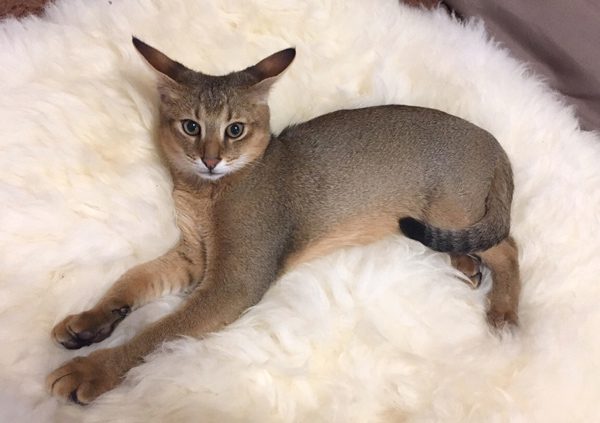
Most often, 3-5 kittens are born in a Chausie.
Signs by which you can suspect pregnancy in your pet:
- Weakness and nausea, lack of appetite in the first 10 days after mating.
- Enlargement and pink color of the nipples.
- Abdominal enlargement at 6 weeks, fetal movement at 7 weeks.
For childbirth, the expectant mother needs to prepare a “nest”. For its device, a box measuring 50 by 60 cm is quite suitable. It can be either cardboard or wooden. It is better to cover the bottom with ordinary newspapers, as kittens can get tangled and suffocate in rag bedding. It is necessary to solve the issue of heating the box – during the first week it is necessary to maintain the temperature in it at about 30 degrees, then every 7 days it can be reduced by 3 degrees. To do this, you need a thermostat or an infrared lamp. Even closer to the birth, you will need to prepare towels, napkins and scissors with disinfected blades.
3-4 days before the birth, the cat begins to worry, scream, refuse to eat. It’s time to show her the box. If she gives birth in another place, then you need to immediately transfer her and the cubs to the box.
Contractions in cats last about an hour, kittens appear every 5-30 minutes, and the birth itself lasts from 2 to 6 hours. Between contractions, you can offer the cat to drink milk to restore strength.
Within 15 minutes after the birth of the kitten, the cat must gnaw through the umbilical cord, if she does not do this, she will have to help her. You need to cut it with scissors at a distance of about 2,5 cm from the kitten’s tummy. After the end of the birth process, the cat lies on its side, and the babies find the nipples and begin to drink colostrum, receiving components from it for the formation of their immunity.
Education
Chausie education, like any other breed, should be started from childhood and immediately after the appearance of a kitten in the apartment. Fortunately, chausies have a developed intellect, thanks to which cats quickly understand what the owner wants. These are sociable and affectionate animals, but they do not like to be picked up and squeezed like teddy bears. Therefore, it is important for the owner to maintain a balance – to give the kitten enough attention and affection so as not to grow an alienated and aggressive beast out of him, but at the same time respect the freedom of will and desires of his pet.
Chausies are sociable and friendly, but they do not like to be in the hands of people, and they prefer to caress only on their own.
The initial task is to accustom the baby to the tray, for this you will need to be patient and kind, because puddles in the house are inevitable. The right choice of place for the tray, filler and close observation of the kitten in moments of anxiety are the main success factors.
It is better that the entire period that it takes to develop a stable habit of urinating in a tray, one of the owners is constantly at home and controls the kitten.
A kitten showing signs of anxiety should be placed in a tray and wait until it goes there. Usually, kids like the filler, and if the owner guessed right with the moment, then the pet will gladly do it in the tray. How to determine that the kitten wants to go to the toilet? He can spin in one place, meow, run around corners, rush about, sit down, sniff the floor or sofa (depending on where he is going to make a puddle). Most often, kittens want to go to the toilet after sleeping, sometimes after eating.
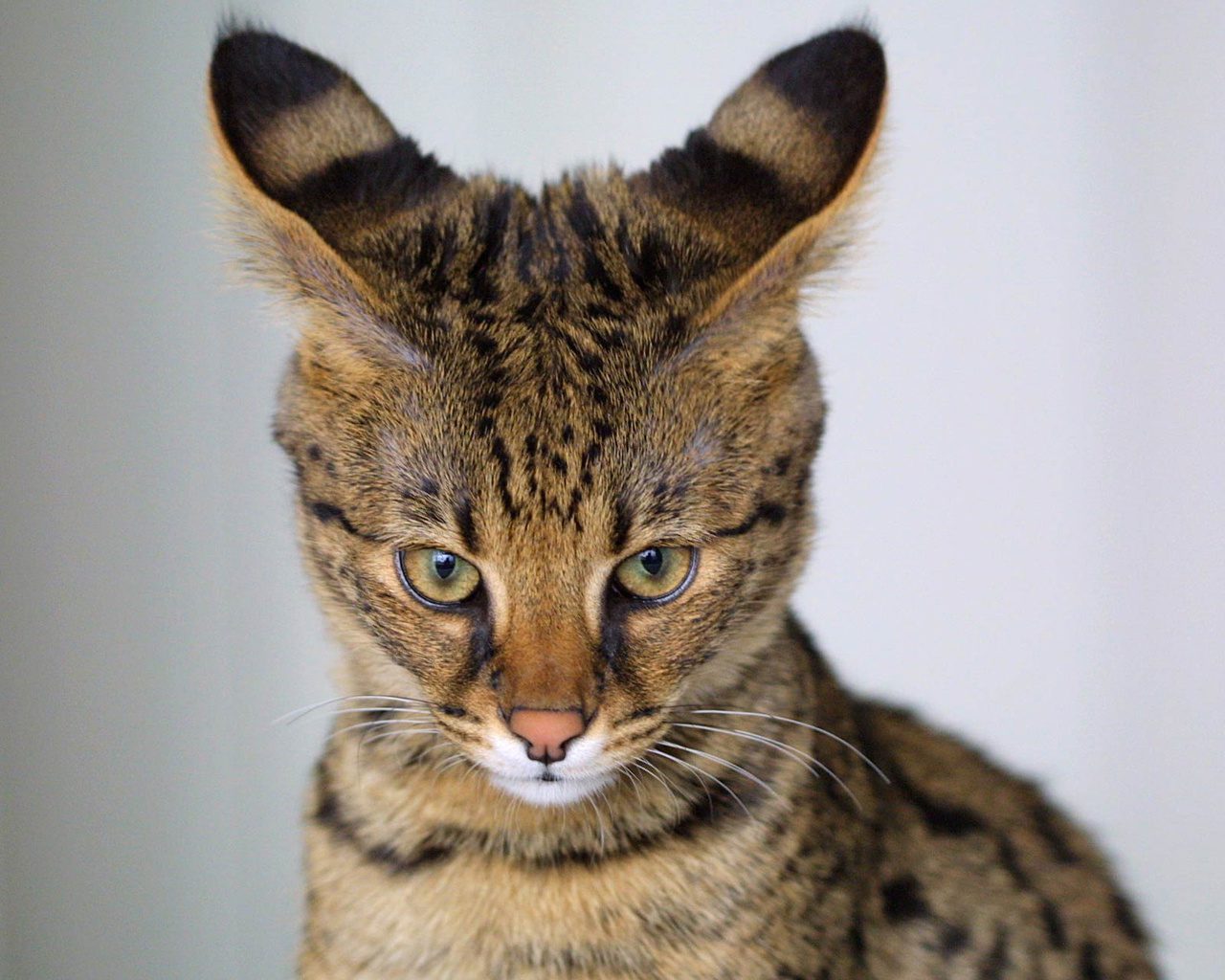
The choice of fillers on sale is very diverse, and if the kitten clearly does not like the contents of the tray, you need to try other options.
For owners who want to immediately teach the animal to go to the toilet, special sets of accessories are sold. But it should be noted that this is not an easy task and requires free time and a lot of patience. If a litter tray for a cat or a cat is a completely natural place that mimics natural conditions, then a clean, smooth toilet with flowing water does not seem so. However, there is one factor that facilitates the process of toilet training of the Chausie F1 – the large size of the animal, allowing it to comfortably sit on the toilet.
Pay attention to the habituation of the kitten to the scratching post. Chausie has sharp claws with which he can ruin the interior of the apartment. With every attempt to claw at objects in the house or wallpaper on the walls, you need to stop this process and explain in a stern voice that this cannot be done here. After taking the animal to the scratching post and show where you can.
It is better to treat the kitten with special products that attract the attention of cats
Particular attention will have to be paid to the issue of harming the owner. Hands, feet and any other parts of the human body are not toys, they should not be bitten or scratched. The kitten must understand these rules for himself from an early age. Otherwise, it will be difficult to cope with an adult animal that decides to attack your legs under the covers on a dark night or grab your hand during the game.
From a young age, it is necessary to teach Chausie to a leash and hygiene procedures. A leash with a harness should be put on the kitten once every few days and lead him around the apartment in it. If the kitten gradually ceases to notice the restrictions and walks calmly, then the goal has been achieved. You can gradually take him outside and continue training in nature. In order for an adult animal to allow the owner to comb out the hair, examine and clean the ears and eyes, cut the claws, it is necessary to regularly carry out these procedures in childhood. The ritual will become familiar from childhood and an adult cat will endure all manipulations calmly.
Diseases and vaccinations
The owner of the Chausie is lucky – apart from sensitive digestion and a tendency to obesity, representatives of this breed have excellent health. Apparently, wild ancestors gave them a stable immunity to colds and infectious diseases. And timely vaccinations help to further increase resistance to disease. Chausies almost never get sick.
Preventive measures and vaccination schedules do not differ from other breeds of cats. The first vaccination against calicivirus, rhinotracheitis and panleukopenia is administered to a kitten at the age of 8-9 weeks, repeated after a month. Additionally, during the first year, the rabies vaccine is administered twice. An adult animal continues to be vaccinated every year.
Vaccination is carried out for Chausie according to the same schedule as for all other breeds.
Before vaccination, you need to conduct a pet deworming course. Approximately 10 days before vaccination, give the kitten a deworming drug suitable for childhood. Remember, an animal that eats raw meat needs regular deworming in the future!
With frequent walks on the street, it is necessary to treat the animal’s hair with special means against ticks and fleas.
Owner feedback
Now I want to tell you about my cat Chausie f2 Henry) the cat is very sociable, walks on the heels like a tail. Likes to walk on a harness down the street. He plays with his toys and the toys of my children) wears them in his teeth like a dog) hides, makes hiding places). But as soon as you pick it up in your arms, it starts to fidget and jump off. You don’t push too hard. If he wants affection, then he will come up and crush with his paws. Even as a kitten, he could come up to smack my earlobe) or comb my hair into a felt boot). He is very sociable with other animals, a dog of the Jack Russell Terrier breed often comes to visit us, they flirt with might and main, then they rest side by side) He likes to swim in care, we put him in an empty shower cabin, put the shower down and turn on the water, he plays with streams and meanwhile the water is filling up. They even threw toys at him a couple of times, they swam around there and he followed them). Lotochek knows with a bang, loves to dig, dig filler). He does not like to scratch, but he allows it. In terms of nutrition, it took a long time to pick up food. Well, sooooo long, even sat on the hills I’d for several months, because there were problems with the chair until they completely switched to a natural table. Only beef, quail, crushed chicken necks, cottage cheese and that’s all, but if he just steals something from the table or gnaws on the food of our Abyssinian, problems with stools return. This breed has a weak digestive system. The fact is that his digestive tract refuses to digest cereals and most vegetables. Therefore, we had to exclude from the diet all food where they enter, including industrial feed. How many have we tried? Another feature of the cat is that it is sterile from birth). His mother is Chausie f1 and his father is Chausie f4, starting from the 4th generation, seals can breed. So we could not castrate him) but we did it when he was 8 months old, on the advice of a veterinarian. No difference in behavior was noticed. This cat can be safely called kotops) and if someone wants a dog but loves cats, then here it is a breed that combines two in one) smart, devoted handsome Chausie) it remains only to teach him to bring slippers in his teeth)
blackiti
I never thought I’d get a pet. Especially, I didn’t think that it would cost like a mink coat … Chausie is a cross between a wild swamp lynx and an Abyssinian domestic cat, from where the wildness and color of the Abyssinian comes from in this breed. The weight of such a cat can reach 15 kg. At first, my choice was a Bengal cat, an animal a la tiger cub. But when I saw Chausie live, it was indescribable. The most beautiful domestic predator! The cat is so beautiful! Very smart and never releases claws on the hostess. The furniture remained intact, as did my hands. Very energetic, ready to play with her favorite toy all day long! A very unexpected feature of this breed: when it runs, it starts to breathe like a dog, opening its mouth and sticking out its tongue. Plus, this cat doesn’t meow! Chausie brings so many positive emotions! Her face reflects any of her moods, she is very funny. From the beast, she has ears with tassels, powerful fangs, with which she gnaws pieces of beef and chicken legs. The wild coloration of my hunter gives an additional animal charm. Health is very strong, which, perhaps, also depends on her diet and additional vitamins. She eats raw beef and premium food.
pgs150
The cat was given to us at 3,5 years old. When she went on a spree, she began to mark everywhere like a cat, so she was quickly sterilized. In the normal state, it always goes to the tray, it can be placed anywhere and there will be no problems. She is kind, affectionate, but does not like to sit in her arms. There are scratching posts, but besides them, it tears up wallpaper, a bed, or whatever gets under its paws (backpack, bag, …). He likes to drink water from the tap, he can sit in the sink and sit there, the same with the bath. Likes to walk on a harness. But you won’t get far with it. She likes to walk slowly or just stand. At home, a small child and when he cried, she came up to bite him and tried to drag him away. After they explained to her that this should not be done, when crying, she began to bite the one who was next to the baby. He eats grain-free food, we also sometimes give meat. She is a thief, she can steal a whole loaf and hide it somewhere under the bed. She practically does not meow, and this is good, because her voice is nasty)) She sleeps during the day, and starts playing at night. It runs like a horse around the apartment, demolishing everything in its path. She is practically not interested in toys, she needs a person. Attacks legs and arms. Clings with claws and teeth. It bites very painfully. Sometimes it’s even scary from her wildly wild games. And so she is not aggressive, if she does not like something, she will simply leave. She has a little wool. In character and appearance, it is very similar to the Abyssinian, only much larger.
Sonny
My friends gave me Chausie for my birthday (boy). He is now 6 months old, already the size of a large cat. The character is calm, plays a lot with himself and just with children. Not aggressive, likes to eat, thieving (as soon as you turn away, your turkey is already cracking))) Feature – it takes a very long time to get used to new people, does not let everyone near him. The behavior is more dog-like than that of a domestic cat. Very funny champs when eating. He understands that they are laughing at him – he is offended and leaves. Very jumpy. And what a wonderful cat.
Dmitriy
The Chausie cat has many advantages, among which the sociable character stands out, making it not only a pet, but also a friend or even a family member. Therefore, the breed is definitely worth recommending for purchase, despite the high price of animals. But keep in mind that Chausie is strongly attached to the owner and needs constant attention and communication with him. If the lifestyle and busyness of the owner do not make it possible to devote time to the pet every day, and there is often no one in the apartment, then it is better to pay attention to another breed.





